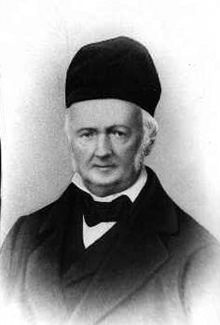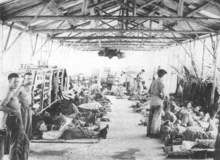Friedrich Koch (pharmacist)
Johann Friedrich Ludwig Koch (born December 7, 1786 in Messel ; † August 13, 1865 in Oppenheim ) was a pharmacist and inventor of the industrial production of quinine .
Life
Start in Oppenheim
The pastor's son Friedrich Koch came from Messel near Darmstadt and completed an apprenticeship as a pharmacist in Zwingenberg . He later worked in various pharmacies (including in Frankfurt and Strasbourg ) and studied pharmacy in Giessen .
He wanted to settle in Oppenheim in 1821 and take over the Löwen pharmacy, which had been in the impressive Landschreiberei Baroque building from 1709, later the house of the casino company and today's Hotel Merian, since 1740. Right at the beginning of his later successful career, he ran into difficulties because the Rheinhessisches Medizinalkollegium in Mainz did not want to recognize the exam acquired in Hessen. A very high decision from the grand ducal residence in Darmstadt was required to start business. In April of the first year of 1821, Koch moved his Löwen pharmacy to the opposite house "Schönecke" at Krämerstrasse 2 and the business premises of the quinine sales department at No. 1.
Malaria in the Rhine lowlands
A second obstacle determined his further life. A violent intermittent fever in the form of the malaria typhoid forced him to consider the possibilities of treating this painful and painful disease. In Oppenheim, malaria occurred to an increasing extent due to the swamps in the Unterfeld that were created by the pushed back Rhine . A large part of the population suffered from it every year. However, the closer connections were not yet known at the time. It was not until 1880 that the French doctor Alphonse Laveran discovered the pathogen, the Apicomplexa Plasmodium . The transmission of the pathogen by the Anopheles mosquito was not even recognized until 1897.
Quinine as an antidote
Inca Indians knew that the bark of the chinchona tree , which grew on the slopes of the Andes, was effective against malaria . South American drivers brought the information to Europe. The progress made in chemistry made it easier to extract the active substances quinine and chinchonine from the bark. However, the price was so high that only very well-to-do patients and thus a small minority could afford treatment and thus alleviation of their suffering. What was missing was the process to produce the two substances in larger quantities and thus cheaper. As we know today, quinine acts as a plasma poison by inhibiting cell metabolism and thus lowering body temperature (including fever), and it also affects plasma movement. Malaria pathogens are particularly sensitive here. However, the formation of stimuli and the conduction of excitation in the patient's smooth muscles, particularly in the heart, are also inhibited as significant side effects .
Koch's method of making quinine
Soon after taking over the pharmacy, Koch tried to extract the active ingredient quinine as pure as possible from the cinchona bark. His customers suffering from malaria should receive an inexpensive and quality-assured preparation.
The German chemist Friedlieb or Friedhelm Ferdinand Runge was the first to isolate a crystalline powder from the bark in 1819, an alkaloid, which he named quinine. A year later, the French pharmacists Pierre Joseph Pelletier and Joseph Bienaimé Caventou also succeeded in doing this . Their publications and his teacher Fabricius in Frankfurt encouraged Friedrich Koch to look for his own inexpensive process for the production of crystalline quinine. In 1823 he finally got the big hit and he started extracting quinine from cinchona bark. The actual recipe has remained the trade secret of the Koch company. The industrial processing phases - in this form and size a novelty, at least for Germany - are known.
First of all, the bark samples offered by various bark importers had to be checked for their quinine content and the appropriate raw product selected. The bark, which was then ordered and delivered in large quantities, was crushed and ground. A steam engine procured in England operated the mill via transmissions, in which the bark was crushed into powder. By stirring the ground material with milk of lime, the alkaloids contained in the bark were separated from the quinine and tannic acids associated with them. A stirrer mixed the lime milk pulp with warm oil so that the released alkaloids dissolved in it. After the mixture had settled, the alkaloid-containing oil layer could be filtered off with suction and washed out with dilute sulfuric acid. The alkaloids were bound in the form of sulfates; the oil could then be used again. The high consumption of hydrochloric acid suggests that Koch tried to separate the various alkaloids from one another. The fact that the oils and alcohols used for the extraction could be reused without loss was probably a major factor in the cost-effectiveness of the process.
Help only for the rich?
Friedrich Koch tried very hard to make quinine, which is still relatively expensive, also available to poor people. In an original draft of a communication that was probably never published, Koch describes a less complex process for the production of a "resinous quinine" and suggests that it be included in the general drug lists. He recommends (literally)
- "The doctors should use it especially for the poor, which means that it gets a cheap price, and prescribe the expensive quinine sulfuric acid for the wealthy."
This substance, called chinoidin, was about a third the price of quinine sulfate. Koch always endeavored to help the secondary alkaloids of the cinchona bark to be recognized and brought mainly the chinoidin discovered by Winkler and the quinine isomer, quinidine and its salts, known under the name Betachinin-Koch, on the market.
Pharmaceutical Industry
Friedrich Koch's customer list is remarkable from a historical perspective. In a lively business relationship, he supplied Emanuel Merck (Darmstadt), Johann Rudolf Geigy (Basel), Pierre Joseph Pelletier (France) and Johann Daniel Riedel (Berlin) , who were known at the time as a pharmacist and now partly as a large pharmaceutical company, as well as the pharmaceutical trader and quinine producer Friedrich Jobst (Stuttgart).
In "Patriotic Reports for the Grand Duchy of Hesse" 1835 the following information can be found:
- “Amongst the excellent chemical factories in Germany we can brazenly count those of Mr. Koch zu Oppenheim in quinine and quinonine, which he has been running for 12 years, earning a well-deserved reputation throughout almost all of Europe. Mr. Koch obtains the china (the common term for cinchona bark) directly from the seaports. His products are of an in fact unsurpassable quality and of a cheapness that suggests that he is in possession of an expedient process. It is known that China is one of the most expensive raw materials. A centner of China supplies a maximum of 3 pounds of quinine sulfuric acid, only in the most fortunate case. Not infrequently, as we can state from a reliable source, Mr. Koch has over three quintals of this preparation, which includes at least 100 cents of China, in stock, from which the scope of the business can be seen. "
Friedrich Koch sold the Löwen-Apotheke (laboratory and first production facility) in 1850 and built Germany's first pharmaceutical factory in the Wormser Straße 62 property, the former property of the von Rodenstein / Schmittberg family, where his descendants still live today as winery owners.
After his death in 1865, his son Carl Koch , who later became mayor and honorary citizen of Oppenheim, took over the factory.
Achievement and importance
In its heyday around 1850, the Koch factory produced up to 60 tons of quinine a year. Friedrich Koch was the undisputed market leader in Germany with a market share of 80%. At that time, three quarters of the world's demand came from Germany, which means that Koch in Oppenheim alone covered 60% of the world's demand.
The Wiesbaden chemist Dr. Ernst Schwenk gave a lecture in November 1999 with the summary claim: The anti-fever drug quinine, manufactured by Friedrich Koch, changed the world. He justified this with remarkable statements:
- Population explosion: Until the 20th century, the increase in world population was limited. This was mainly due to the fact that in India, Africa and America, but also in swampy areas of Europe, millions of people mostly died of malaria in childhood, thereby compensating for the excess birth rate. Only since there were effective therapies against malaria has the world population increased rapidly. Friedrich Koch from Oppenheim made a significant contribution to this.
- Colonization: Without a cure for malaria, Europeans would have been in a bad position to establish colonies in Asia, East Africa or South America. Hardly any officer or civil servant would have declared himself ready for the service if he had to reckon with falling ill with the dreaded incurable intermittent fever in the second year of his stay at the latest.
- Slavery: In the 17th century, the Americans initially used Indians as labor on their plantations. After they died defenseless from malaria introduced by the emigrants, natives from West Africa, who were almost resistant to the disease, were deported to America as workers. Had some cure for swamp disease been available, the slave trade would probably not have reached the horrific proportions it has known.
literature
- Dieter Horst: Biography Friedrich Carl Koch published in Oppenheim, History of an old imperial city (on the occasion of the 750th anniversary of the city elevation), Oppenheim 1975, pages 252-254, publisher: Dr. Hans Licht (Dr. Martin Held Foundation)
- Hellmut Wernher: Oppenheim as the cradle of the pharmaceutical industry , article in the Mainzer Allgemeine Zeitung of November 30, 1999 about a lecture by the Wiesbaden chemist Dr. Ernst Schwenk published in Oppenheimer Hefte No. 21 - May 2000, page 72, ISBN 3-87854-150-3 (Ed. Oppenheimer Geschichtsverein, written by Dr. Martin Held)
- Ernst Schwenk: The cradle of the pharmaceutical industry was in Oppenheim , published in Oppenheimer Hefte No. 22 - Dec 2000, pages 2–21, ISBN 3-87854-154-6 (Ed. Oppenheimer Geschichtsverein, published by Dr. Martin Held)
- Judith König, Hilmar Liebsch, Martin Rosenberg, Tanja Winkler: Malaria - mosquito bite with disastrous consequences . here especially page 3: history of malaria , script for the WDR series “Quarks & Co” online version as PDF file
Web links
- Short biography of Friedrich Koch on the homepage of the Carl Koch Erben family
- Jutta Hermann: cinchona bark - a historical journey around the world . Article in the Pharmazeutische Zeitung, Govi-Verlag, 2001 available online
Individual evidence
- ↑ on the family homepage it says August 17th: to be clarified !!
- ↑ see history info and pictures on the website of Hotel Merian
- ↑ here is the beautiful but possibly made-up story about the origin of the name quinine
- ↑ from the family homepage www.ck-wein.de
- ↑ see literature Ernst Schwenk: The cradle of the pharmaceutical industry was in Oppenheim
| personal data | |
|---|---|
| SURNAME | Koch, Friedrich |
| ALTERNATIVE NAMES | Koch, Johann Friedrich Ludwig (full name) |
| BRIEF DESCRIPTION | Pharmacist and inventor of the industrial production of quinine |
| DATE OF BIRTH | December 7, 1786 |
| PLACE OF BIRTH | Messel |
| DATE OF DEATH | August 13, 1865 |
| Place of death | Oppenheim |






